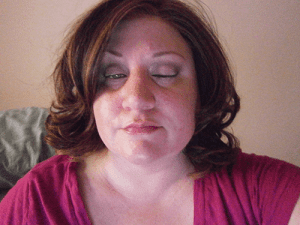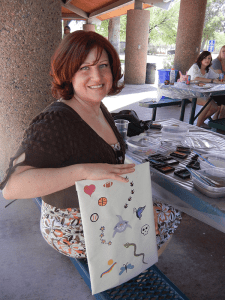I’ve been using internet dating sites for the past eleven years. I have also been dealing with a rare and undiagnosed disease for the past five and a half years.
The disease is seriously cramping my style as a forty-one-year-old single woman – I am convinced I am not supposed to be single for the rest of my life. However, finding men who will date me is a completely different story.
I actually have a long history of health issues. By age two, doctors confirmed I had allergies and asthma. At age five I began losing perfectly round circles of hair – alopecia areata. The hair would always eventually grow back but then new patches would fall out. It was manageable. At age twenty-three I was diagnosed with fibromyalgia, putting a name to my crippling pain and fatigue.
When I was twenty-four, my hair began a mass exodus, prompting me to get approximately seventy-five steroid shots in my scalp every three weeks to try to counteract my immune system’s attack on my hair follicles. I gave up the fight after four years when the alopecia progressed to universalis and I’ve been completely hairless ever since – the upside of that, of course, is that I haven’t had to shave my legs in thirteen years. At age 30, Hashimoto’s thyroiditis was added to my list. I have been able to manage it for the most part, but it explains why I gain weight easily and tend to be constantly cold.
If you are imagining me to be fat and bald, then you are correct.
Being single and trying to date as a bald woman is not for the faint at heart. One man that I met on OKCupid seemed to be a pretty good match for my personality, and we were enjoying dates out to shows and dinners. At date six, he reached up to affectionately put his fingers in my hair when dropping me off at my house, and I stopped him, explaining that I wore wigs. He pushed himself away from me and squeezed himself up against his car door, looking at me as if I were his aunt trying to make out with him. This man was rounder than me and his hair loss rivaled mine. He couldn’t lose my number fast enough. Pot, meet Kettle?
I wish I could say that his reaction is the exception, but it’s not – and believe me when I say that I’ve been on many dates.
The mystery disease struck in 2010. I remember nearly falling down an entire outdoor cement staircase because I was suddenly hit with waves of vertigo. Within days it progressed to add crushing fatigue, a constantly nodding head, blurred vision, a paralyzed forehead and both eyelids drooping with the left being more affected. My cortisol levels shot up to ten times the normal limit and my blood pressure instantly jumped to dangerous numbers.
My breathing became shallow and my voice lost all intonation – think Frankenstein’s monster.
It took me a year to find a doctor who had a viable solution. During that time I saw many endocrinologists, rheumatologists and neurologists, all of them telling me they didn’t know what I had and that it was probably psychosomatic anyway. I have been convinced since the beginning that it’s another manifestation of an autoimmune condition, but so far no test results can detect exactly what it is, including MRIs of the brain, which always get a “normal” report. A neurosurgeon with Barrow Neurological Institute implanted a shunt in my spine to pull fluid off of my brain after I had two lumbar punctures in four days, and for twelve hours each time my symptoms resolved, indicating that a constant removal of the CSF would give me relief.

Unfortunately, my body does not like having a foreign device in it. From June of 2011 to May of 2015 I have had a total of ten surgeries, all of them ultimately failing. The devices have cracked and broken or have clogged. Occasionally I have had large pools of CSF in my back.
The shunt locations were changed so that they started draining directly from my brain, but that had no positive effect on the duration of the devices.
My abdomen has also been cut every time the surgeons needed to guide the drainage catheter to my peritoneum, leaving the skin marred with numerous scars.
I had to give up my vanity when I started having so many surgeries and complications, which means that I often wear a scarf instead of my wigs when out in public – I have been in the ER on a gurney many times, and the hair is just a hassle. In a way, it is strangely empowering. I finally feel as if my appearance matches my diseases. However, when I go out in public like this, I am always asked what kind of cancer I have. People react with disappointment and anger when I explain that it’s not cancer but I don’t have a diagnosis, as if I am faking my conditions.
I have had to go through physical therapy to learn to walk properly again twice after having CSF pool on my brain and push on my nerves for months at a time during shunt failures, making my feet turn inward and flop when I walk. I try not to date when I look and sound like Quasimodo, so there have been big breaks in my socializing. When I have had a working shunt and I look normal, I have tried to fit in as much dating as possible; it’s in my nature to never miss an opportunity, because I can’t predict when I’ll be out of commission next.
A time that still makes me cringe is a 911 call I had to make in May of 2014.
I had excruciating pain in my head and had just taken a painkiller; when I moved to lay down, I felt a sudden poking and burning pain in the right side of my head behind my ear, exactly where my shunt was located. The area began to swell and was hot to the touch.When I got the 911 operator, my speech was slurring. The firemen showed up about four minutes later and started working on me, and it was just my rotten luck that every single one of them was drop-dead gorgeous and looked like they belonged in a firemen fundraising calendar, and I had to have my hair off so they could examine me. I owned a beautiful house at the time and the guys who weren’t working on me walked through the rooms to check my place out, yelling how much they loved it.
According to the monitor, my heart was in distress – and I’m not sure if it’s because of what was happening with the shunt, or having a house full of handsome men. They opted to run me to the hospital. As they were strapping me in and wheeling me out, my pain pill kicked in full force, so, high as a kite, I said to all of them, “I’m looking for a roommate! You can have the bedroom right next to mine. I’m serious. Call me.”
There is nothing like a fat, bald and high woman trying to pick up firemen, let me tell you. Prime example of never missing an opportunity right there.
In June of this year I had to give up that beautiful house in Phoenix and move back to Minnesota to be closer to my family so they could help me with my basic needs. I made the decision after the neurosurgeon chose to stop operating on me when my shunt failed again just seventeen days after my most recent surgery on May 11th. I can’t spend more than thirty minutes upright before the CSF starts to pool and press on my brain, making my face droop and the world swirl around me. I can’t drive and I can’t work. I can’t even take a bus because I can’t see well enough to pay my fare or navigate getting to and from the bus.
I have been turned away from the Mayo for the fifth time, their rejection letter stating that my disease is too rare to get a diagnosis or treatment. I have also managed to puzzle six doctors locally to date, so I can’t see my situation changing anytime soon. I spend my days lying flat, which allows the CSF to move away from the areas it presses on, and I can open my eyes fully. I look and sound like my old self only when I’m laying down.
This is where the big dilemma comes in: I’m in a new city, which means it’s a completely different dating pool and could possibly yield an actual love match. However, I can’t drive, I can’t take the bus, I use a cane to walk, and I can’t work. I am the one I’d be opposed to meeting through an internet dating site if the tables were turned. It has been incredibly difficult for me to accept that this is my new reality.
I still desire love and affection and companionship, but is it fair to “waste” the time of men on OKCupid who are looking for able-bodied dates who can actually go out to dinner?
 About the Author: Patient Worthy Contributor, Chelsea. Keep an eye out for posts from her as she navigates the gnarly dating world, chronic illness and searches for a diagnosis and check out her blog, The Sick and The Dating.
About the Author: Patient Worthy Contributor, Chelsea. Keep an eye out for posts from her as she navigates the gnarly dating world, chronic illness and searches for a diagnosis and check out her blog, The Sick and The Dating.





